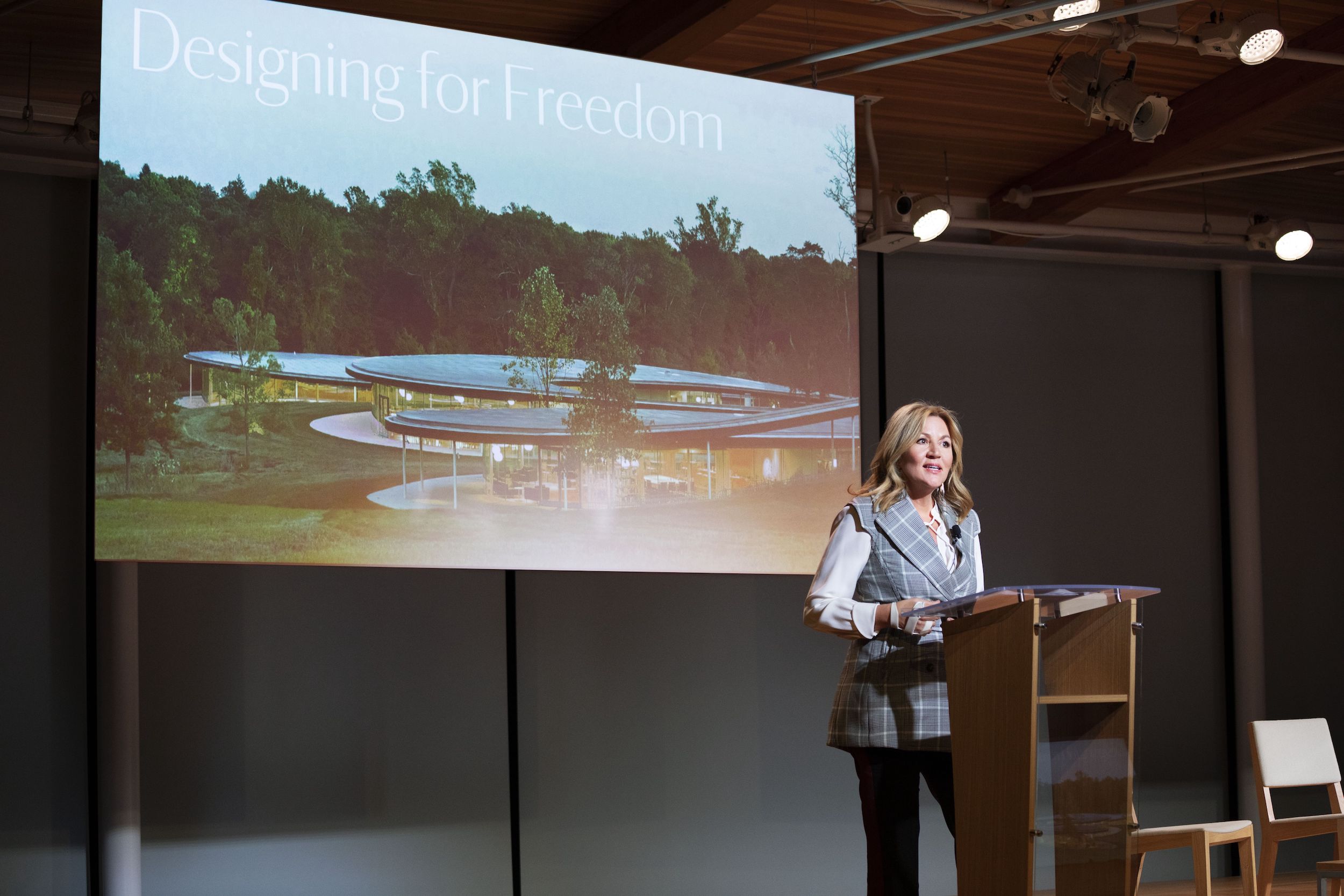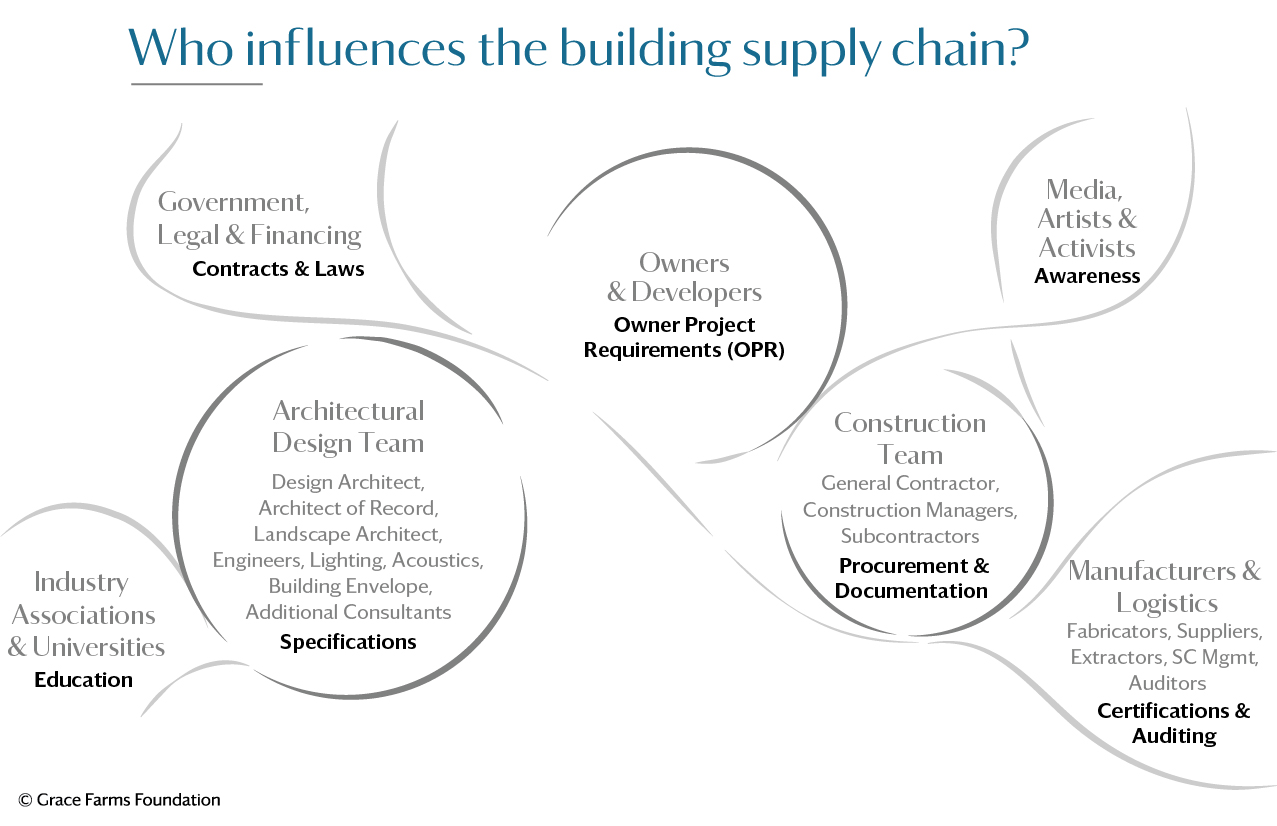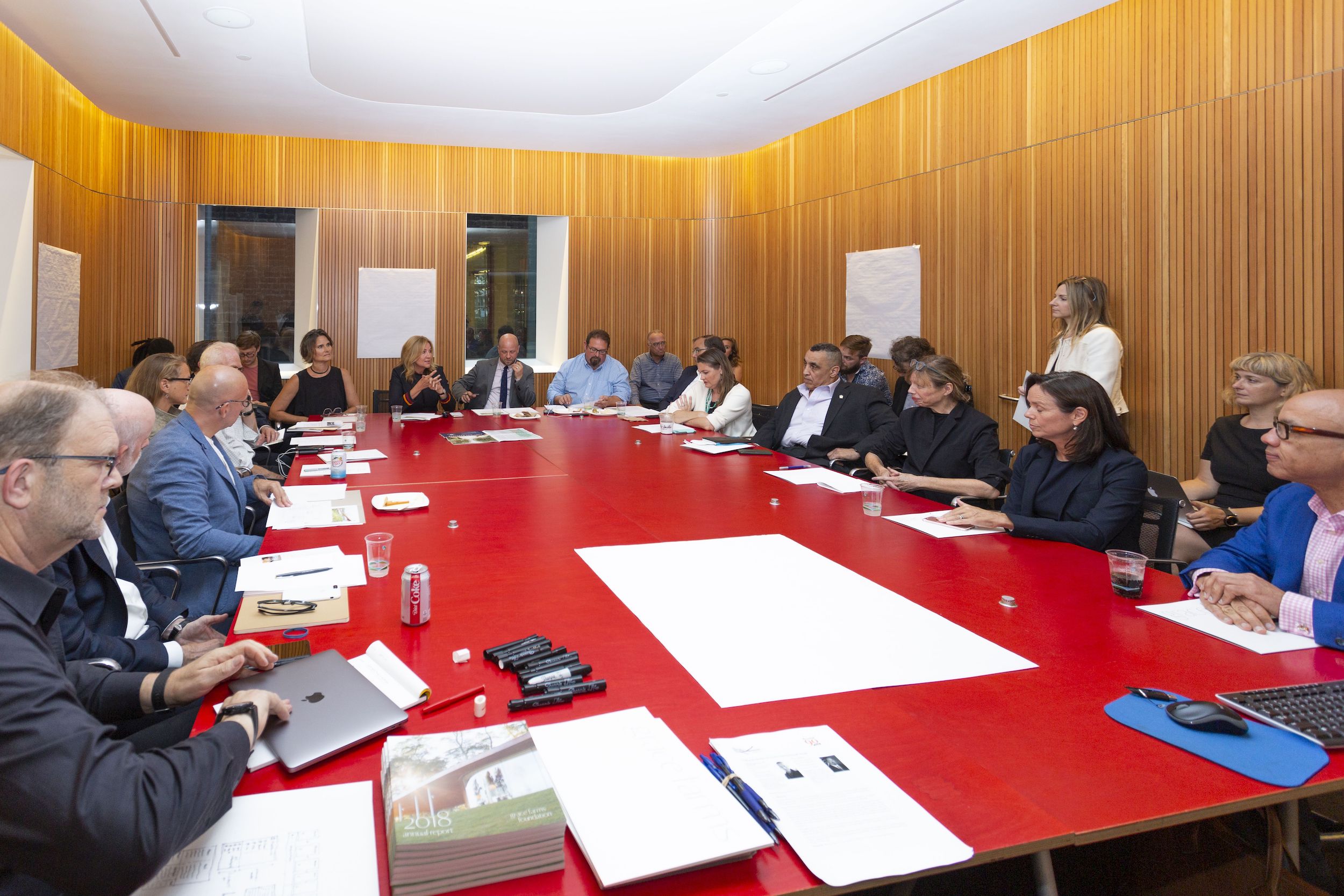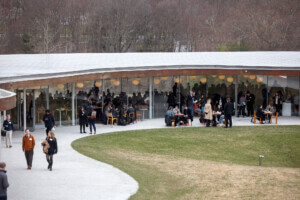The New Canaan, Connecticut-based Grace Farms Foundation has officially launched Design for Freedom, a multifaceted new initiative that addresses head-on the insidious and chronically-overlooked crisis of systemic forced labor within the building materials supply chain. Centered around a historic report spanning nearly 100 pages, Design for Freedom also includes a robust, resource-filled website, an upcoming webinar series, educational partnerships at major universities, and more. AN first wrote about the then-nascent movement, of which it has special ties, in September 2019.
Involving dozens of experts and leaders from across a broad swath of the architecture, engineering, and construction industry, Design For Freedom is the result of a herculean effort that can be traced back to the fall of 2017 when Sharon Prince, CEO and founder of Grace Farms Foundation, and Bill Menking, the late co-founder and editor-in-chief of AN, convened at Grace Farms’ SANAA-designed HQ in New Canaan to discuss the staggering global prevalence of modern slavery practices within the built environment—a crisis that they believed to be routinely swept under the proverbial rug by the AEC industry both domestically and abroad. From there, Prince and Menking set out to not only raise awareness of forced labor within the industry but also find ways to wholly eradicate it in favor of an ethical supply chain untainted by human bondage and suffering.
Per Design for Freedom, over a dozen building materials, both raw and composite, are at risk of forced labor. The $11.4 trillion construction industry is the top offender within the industrial sector when it comes to the risk of unethical and illegal labor practices.
“Since the inception of Grace Farms, we have been committed to disrupting and ending the brutality of modern slavery and gender-based violence through advocacy, training and strategic partnerships,” Prince told AN of the movement’s beginnings. “A few years ago, after realizing that there was an industry-wide lack of attention to unethically sourced building materials, I spoke to Bill [Menking] at Grace Farms and he agreed that there was no attention being paid to the use of forced labor in the building material supply chain. I proposed that we start a working group to address this critical issue, and in true Bill style he didn’t hesitate. He would be so thrilled about our burgeoning architecture justice movement taking shape in the sector he was so immersed.”

Since Prince and Menking’s initial conversations regarding a massive issue that was—and still is—receiving a woeful amount of widespread attention, Design for Freedom has evolved into a proper movement with the aforementioned report, also titled Design For Freedom, serving as both a guiding document and resource. It addresses and analyzes the scope and severity of modern slavery in building materials supply chains while also detailing actionable steps that those working within the AEC industry can take to lessen their dependence on unethically- and illegally-sourced materials and, ultimately, eliminate forced labor, human trafficking, and other practices. While some attitudes might veer toward something along the lines of it’s been like this forever and I’m not sure my firm/company can help to change anything on a larger scale, Design for Freedom aims to prove that impactful change is possible when awareness is raised and collective action is taken.
“First, we had to figure out who influences the supply chain and then invite ethically-minded principals and industry leaders who could make inroads fast,” explained Prince of the initial establishment of the Design for Freedom Working Group, who has expanded dramatically since its inception as the Grace Farms Foundation Architecture + Construction Working Group. “We started with the innovative people [Shohei Yoshida and Peter Miller among others] with whom I have spent countless hours designing and building Grace Farms. Then, Bill and I invited leaders we knew had an antenna for the ethical advancement of the industry. Today, we are more than 60 strong, along with the support of our incredible Grace Farms Foundation team and we are energized to announce and add velocity to the Design for Freedom movement.”
“A movement starts from within, but it takes hold when the full ecosystem of an industry is using their wherewithal and applying pressure from many angles,” added Prince. “Design for Freedom has an audacious goal to move an entire global industry that has been subsidized by free, forced labor for centuries toward slave-free buildings.”

The report itself—available to view in full here—was written and edited by Prince along with Luis C.deBaca, the Obama administration’s Ambassador-at-Large to Monitor and Combat Trafficking in Persons and Senior Justice Advisor at Grace Farms Foundation, and Chelsea Thatcher, founding creative director and chief marketing officer with Grace Farms Foundation.
Contributors to the expansive report, which opens with a new poem from 2019 Grace Farms artist-in-residence Carrie Mae Weems, include Phil Bernstein, associate dean at the Yale School of Architecture; Christian Benimana, senior principal and managing director, Kigali, Rwanda, MASS Design Group; Bill DuBois, construction specifier and architect at Gensler; Michael Green, principal of MGA | Michael Green Architecture; Gabe Guilliams, principal lighting specialist at BuroHappold; Harriet Harriss, dean of the School of Architecture at the Pratt Institute; Jing Liu and Florian Idenburg, founding principals of SO – IL; Joseph Mizzi, president and COO of Sciame Construction; Nat Oppenheimer, executive vice president at Silman; Fiona Reynolds CEO of Principles for Responsible Investment (PRI); Ann Rolland, partner at FXCollaborative; Adam Saltzman, director of MASS.Build; Christopher Sharples, founding principal of SHoP Architects; Hayes Slade, co-founder and principal of Slade Architecture; Franca Trubiano, Ph.D., University of Pennsylvania, Weitzman School of Design; Brian Ulicny, founding member of Thomson Reuters Labs in Boston; Darren Walker, president of the Ford Foundation; and Claire Weisz, founding principal of WXY Studio, among others.
(A full list of all experts and industry leaders participating in the Working Group can be found here.)
In a press statement, Benjamin Prosky, executive director of American Institute of Architects New York Chapter (AIANY) and the Center for Architecture, described the report as being “essential reading for everyone involved in the design and construction industry.”
“As a complement to the AIA Code of Ethics, which asserts that members should uphold human rights in all their professional endeavors, this report provides invaluable perspectives that underscore an architect’s obligation to enhance and facilitate human dignity and the health, safety, and welfare of everyone who uses, as well as creates, their buildings,” Prosky added.

As mentioned, the report is complemented by a website featuring original content as well as tools and checklists geared toward five core audiences: design/architecture teams, construction teams, manufacturers/importers, owners/investors, and academia. That last audience, academia, is one that will also benefit from a series of planned lectures on modern-day slavery and the built environment organized by Prince and other members of the Working Group. This initiative includes a first-of-its-kind class at the Yale School of Architecture led by Bernstein and deBaca that examines labor practices in the building materials supply chain. Other schools partnering with Design for Freedom include Cooper Union, IE Business School in Madrid, the Illinois Institute of Technology, New York University, Parsons, Pratt Institute, and Princeton University.
What’s more, a two-part webinar series presented by Grace Farms and Pratt Institute will kick off on October 29 with “Innovative Tools in the Movement Toward Slave-Free Buildings.” The panel discussion will feature Prince in conversation with Bernstein, Harriss of the Pratt Institute, SHoP’s Sharples, and others. Following that is a planned November 17 webinar that will examine how industries outside of the AEC realm have successfully dealt with diminishing/eliminating forced labor from their respective supply chains.

Lastly, Michigan-based furniture-maker Herman Miller, a Working Group member, is set to introduce a series of Design For Freedom reusable face masks designed as part of a pro bono collaboration with Shohei Yoshida, principal of shohei yoshida + associates/SYA and formerly of SANAA, and Peter Miller, founding partner of New York-based architecture firm Palette and formerly of Handel Architects. The latter firm served as executive architect on the River building, the landscape-integrated built centerpiece of Grace Farms’ tranquil 80-acre campus and the first U.S. project to be helmed by Tokyo-based SANAA after winning the 2010 Pritzker Prize. (Several members of the River building project team from firms including BuroHappold, Silman, and Sciame are also part of the Design for Freedom Working Group)
Ethically manufactured in a women-owned facility, the soon-to-be-available face masks, which sport a distinctive design inspired by the roof of the River building at Grace Farms, will be sold through the Design Within Reach webstore. All proceeds from the sale of the masks, which are being sold as part of the Grace Farms Foundation’s larger efforts to supply PPE during the COVID-19 pandemic, will benefit the Design for Freedom movement.
“We need this change to happen quickly,” said Prince. “The green building movement took 25 years to take hold, but we don’t have that long. The disaggregated construction industry is ripe for disruption and the time is now to mandate slave-free criteria and to leverage emerging technologies to do so.
“Today, we are asking all who influence the supply chain— including architects, engineers, construction teams, manufacturers, academia, lawyers, activists, and owners—to look beyond the perimeter of the job site and address the pervasive and inhumane slave-labor in our building materials supply chains.”










